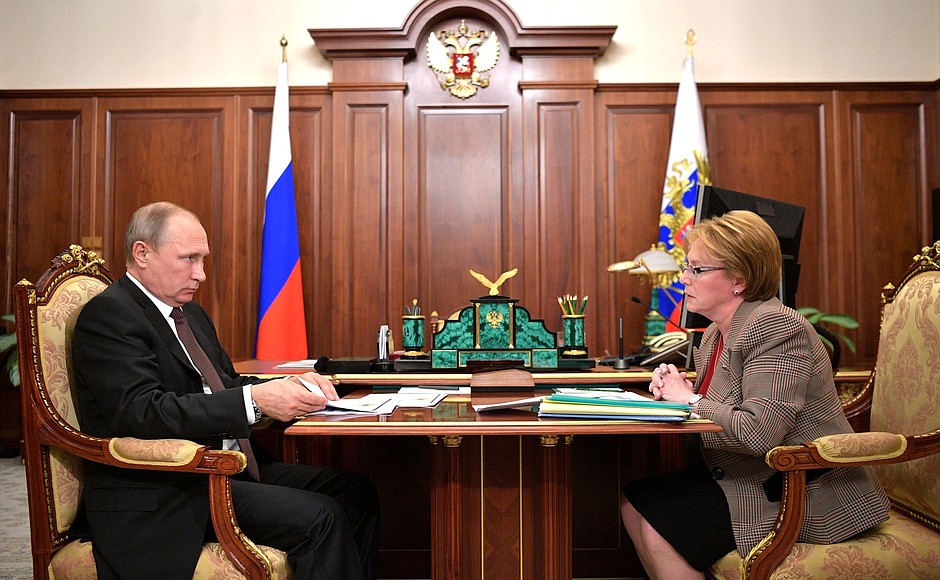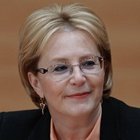President of Russia Vladimir Putin: Ms Skvortsova, there are many questions, of course, since you work in a very active field. Let's begin with the availability of medical care.
Healthcare Minister Veronika Skvortsova: Thank you, Mr President.
Actually, this is the most common reason for complaints to the Ministry, to Roszdravnadzor or regional healthcare departments. We began to deal with this problem systematically from 2014–2015. First, we updated the entire Soviet regulatory framework on demand for medical infrastructure in various locations, with differing populations and distances to the nearest medical centre. For the first time, we established wait time deadlines for medical care of various types – emergency, intensive care, primary care, district doctors, planned hospitalisation, and so on.
Based on this information, we created a geo-information layered interactive map, which shows 157,000 localities, all transport infrastructure and 74,000 medical centres. This map helps automatically calculate the time and distance for each locality to provide a specific type of medical assistance.
This slide shows an example: two towns – Apatity and Kirovsk – are 17 kilometres away. This programme automatically calculates the time, taking into account the condition of the roads, even making seasonal adjustments – 23 minutes.
We can see all available medical institutions with their capacities, beds, specialisation and so on, for each location, respectively. This map allowed us to estimate the risks for each region, for residents in each locality by the beginning of 2016. By May 2016, we concluded agreements and signed road maps with all the regional governors to eliminate the risks and shortcomings that we identified.
Over the past five years, we have built 2,000 new medical facilities, most of which are primary care and rural medicine facilities. In 2016, we built more than 550 facilities, 500 of which are paramedic centres, rural medical assistance centres, rural outpatient clinics and offices of general practitioners. Over the past five years, 20,000 medical institutions have been renovated, 2,650 of which were renovated in 2016. They are primarily small facilities but are of great importance for patients in need of primary medical care.
Nevertheless, as of January 1, 2017, out of 157,000 localities, we still have 9,900 whose population has limited access in accordance with the norms of medical care of one kind or another.
I would like to note that there are 80,000 localities with the population of up to 100 people, 8,866 of which do not have access to primary care in close proximity (at least within an hour). There are 43,000 localities with population from 100 to 1,000 people, 865 of which do not have enough paramedic centres; localities with population from 1,000 to 10,000 people lack 169 rural outpatient clinics.
In view of the absolutely clear shortage, we have developed a priority project programme for building paramedic centres and rural outpatient clinics and purchasing of mobile diagnostic modules. This priority project was preliminary discussed in the Government at the level of deputy prime ministers, it was approved, and we hope that in the near future it will be implemented to help the regions.
In addition, we have been implementing for the second year a programme to modernise ambulances. Last year, we upgraded 37 percent of class B ambulances with a run-on operation of over five years and 19 percent of class C ambulances (mobile ICUs). This year, the programme will be continued, and at least a thousand vehicles will be purchased for the regions.
In addition, for the first time this year we are carrying out a programme to develop air ambulances in 34 regions. These are regions with the maximum need for air ambulances; they perform 87 percent of the total volume of services. We are now monitoring this situation. It is developing quite positively, and the regions are very pleased with this opportunity. We hope that this will allow us to accelerate emergency medical care for residents of remote areas.
Mr President, the project we are carrying out with Rosatom experts called Economical Clinic, or a ‘technology factory’, is an important initiative to increase healthcare accessibility. I reported to you about this project last March. At the time the project had been implemented at six outpatient clinics in only three regions, while now it has expanded to 99 clinics in 37 regions. Waiting times have decreased 12 times, appointments have become easier to make, the so-called polite receptions are operating – and this did not require any excessive resources and happened only due to established logistics and better management. It is important to note that there are different lines for patients with ongoing cases and patients requiring a regular check-up.
As concerns preventive medical examinations, the first stage can now be completed in one visit. So the programme is working. I selected several recent examples for you, from Udmurtia, Buryatia, Yaroslavl Region, Kaliningrad and Sevastopol. Thirty-seven regions are already included in the project. The results have been in fact evaluated very highly by the public. Over the first months since this innovation, the patients’ satisfaction level went up by 10 to 15 percent on average. The patients noted friendly environment and comfort at medical facilities.
Staffing in the healthcare sector is an essential aspect of making healthcare more accessible. We receive many complaints regarding the shortage of primary care practitioners, including specialised doctors.
Vladimir Putin: What is the percentage?
Valentina Skvortsova: Primary care currently lacks 10,700 general practitioners and paediatricians and around 24,000 specialised doctors of 94 specialisations. However, progress has been made over the past three years. The number of doctors in primary care has increased by 37,000 (14 percent), including a 25-percent increase in the number of doctors working in rural areas under the Rural Doctor programme. There has been a significant increase of 10 to 25 percent in the number of the most sought-after specialists, that is, not only GPs and paediatricians (ophthalmologists, otorhinolaryngologists, cardiologists and neurologists are in the shortest supply).
According to our forecasts, we will need two to three years to address this deficit. I would like to report that serious system-wide measures have been taken in order to offset this deficit, prevent it in the future, and ensure that the system is balanced. First, university students will be graduating this year for the first time under a new programme and new standards, including physicians and paediatricians, who can start working only after completing a three-stage accreditation examination. As we increased specialised training, which now accounts for more than 50 percent of the curriculum, and enhanced its efficiency to 90 percent, we will have about 11,000 young specialists ready to start working as physicians or paediatricians in outpatient clinics. Taking into account that 5.5 percent to 10 percent of this workforce retires every year on average, depending on the region, we will resolve this situation in a matter of two or three years.
Vladimir Putin: Do you expect to have a steady surplus?
Veronika Skvortsova: Yes, we have a surplus so far. It is essential that our young specialists find jobs in the regions. We are working hard on it.
This year, the Healthcare Ministry has taken a new step to improve medical residency training. Until this year, people could apply for a state-funded scholarship or enrol on a for-pay basis without passing any exams. This year, however, we issued an order whereby everyone has to go through a basic accreditation examination in order to benefit from graduate medical training. After all, an ophthalmologist cannot treat eyes without knowing how the human body works. In addition, we made enrolment for residency training positions a competitive process, which includes a test, and takes into account the applicant’s achievements, like an honours degree, an individual or presidential scholarship, and work experience at medical institutions. Special credits are given to those who worked as doctors in rural areas. This innovation, which took us a year to develop, will allow us to admit, on an absolutely fair basis, the best students, giving them the opportunity to become specialist doctors.
<…>


